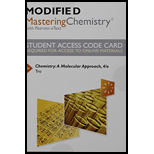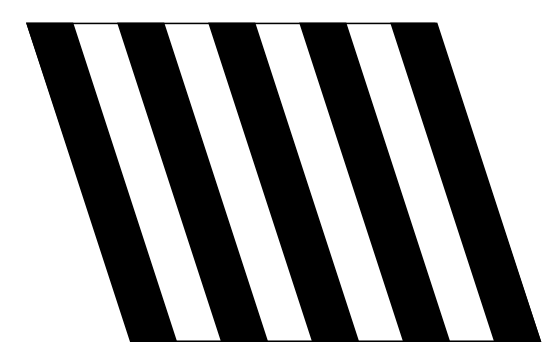
Modified Mastering Chemistry with Pearson eText -- Standalone Access Card -- for Chemistry: A Molecular Approach (4th Edition)
4th Edition
ISBN: 9780134162430
Author: Nivaldo J. Tro
Publisher: PEARSON
expand_more
expand_more
format_list_bulleted
Concept explainers
Question
Chapter 7, Problem 47E
Interpretation Introduction
To sketch: The interference pattern from the diffraction of electrons.
Interference pattern:
The interference pattern can be represented as follows:

Expert Solution & Answer
Want to see the full answer?
Check out a sample textbook solution
Students have asked these similar questions
2. Calculate the branching ratio of the reaction of the methyl peroxy radical with either HO, NO
298K) (note: rate constant can be found in the tropospheric chemistry ppt
CH,O,+NO-HCHO+HO, + NO,
CH₂O+HO, CH₂00H +0₂
when the concentration of hydroperoxyl radical is DH01-1.5 x 10 molecules and the
nitrogen oxide maxing ratio of 10 ppb
when the concentration of hydroperoxyl radicalis [H0] +1.5x10 molecules cm" and the
nitrogen oxide mixing ratio of 30 p
Under which condition do you expect more formaldehyde to be produced and why
Indicate the product of the reaction of benzene with 1-chloro-2,2-dimethylpropane in the presence of AlCl3.
In what position will N-(4-methylphenyl)acetamide be nitrated and what will the compound be called.
Chapter 7 Solutions
Modified Mastering Chemistry with Pearson eText -- Standalone Access Card -- for Chemistry: A Molecular Approach (4th Edition)
Ch. 7 - Which wavelength of light has the highest...Ch. 7 - Q2. Which kind of electromagnetic radiation...Ch. 7 - Q3. How much energy (in J) is contained in 1.00...Ch. 7 - Q4. Light from three different lasers (A, B, and...Ch. 7 - Prob. 5SAQCh. 7 - Prob. 6SAQCh. 7 - Prob. 7SAQCh. 7 - Prob. 8SAQCh. 7 - Prob. 9SAQCh. 7 - Prob. 10SAQ
Ch. 7 - 1. Why is the quantum mechanical model of the atom...Ch. 7 - Prob. 2ECh. 7 - 3. Define the wavelength and amplitude of a wave....Ch. 7 - 4. Define the frequency of electromagnetic...Ch. 7 - 5. What determines the color of light? Describe...Ch. 7 - Prob. 6ECh. 7 - Prob. 7ECh. 7 - Prob. 8ECh. 7 - Prob. 9ECh. 7 - 10. Describe the photoelectric effect. How did...Ch. 7 - Prob. 11ECh. 7 - 12. What is a photon? How is the energy of a...Ch. 7 - Prob. 13ECh. 7 - Prob. 14ECh. 7 - Prob. 15ECh. 7 - Prob. 16ECh. 7 - 17. What are complementary properties? How does...Ch. 7 - Prob. 18ECh. 7 - 19. What is a trajectory? What kind of information...Ch. 7 - Prob. 20ECh. 7 - 21. Newton’s laws of motion are deterministic....Ch. 7 - Prob. 22ECh. 7 - 23. What is a probability distribution map?
Ch. 7 - 24. For each solution to the Schrödinger equation,...Ch. 7 - Prob. 25ECh. 7 - 26. What is the Schrödinger equation? What is a...Ch. 7 - 27. What are the possible values of the principal...Ch. 7 - 28. What are the possible values of the angular...Ch. 7 - 29. What are the possible values of the magnetic...Ch. 7 - 30. List all the orbitals in each principal level....Ch. 7 - 31. Explain the difference between a plot showing...Ch. 7 - 32. Make sketches of the general shapes of the s,...Ch. 7 - Prob. 33ECh. 7 - 34. Why are atoms usually portrayed as spheres...Ch. 7 - 35. The distance from the sun to Earth is km. How...Ch. 7 - Prob. 36ECh. 7 - 37. List these types of electromagnetic radiation...Ch. 7 - 38. List these types of electromagnetic radiation...Ch. 7 - 39. Calculate the frequency of each wavelength of...Ch. 7 - Prob. 40ECh. 7 - 41. Calculate the energy of a photon of...Ch. 7 - 42. Calculate the energy of a photon of...Ch. 7 - 43. A laser pulse with wavelength 532 nm contains...Ch. 7 - Prob. 44ECh. 7 - 45. Determine the energy of 1 mol of photons for...Ch. 7 - 46. How much energy is contained in 1 mol of...Ch. 7 - Prob. 47ECh. 7 - Prob. 48ECh. 7 - Prob. 49ECh. 7 - 50. The smallest atoms can themselves exhibit...Ch. 7 - 51. What is the de Broglie wavelength of an...Ch. 7 - 52. A proton in a linear accelerator has a de...Ch. 7 - 53. Calculate the de Broglie wavelength of a 143-g...Ch. 7 - 54. A 0.22-caliber handgun fires a 1.9-g bullet at...Ch. 7 - 55. An electron has an uncertainty in its position...Ch. 7 - 56. An electron traveling at 3.7 × 105 m/s has an...Ch. 7 - 57. Which electron is, on average, closer to the...Ch. 7 - Prob. 58ECh. 7 - 59. What are the possible values of l for each...Ch. 7 - Prob. 60ECh. 7 - 61. Which set of quantum numbers cannot specify an...Ch. 7 - 62. Which combinations of n and l represent real...Ch. 7 - 63. Sketch the 1s and 2p orbitals. How do the 2s...Ch. 7 - Prob. 64ECh. 7 - 65. An electron in a hydrogen atom is excited with...Ch. 7 - 66. Determine whether each transition in the...Ch. 7 - 67. According to the quantum-mechanical model for...Ch. 7 - 68. According to the quantum-mechanical model for...Ch. 7 - 69. Calculate the wavelength of the light emitted...Ch. 7 - 70. Calculate the frequency of the light emitted...Ch. 7 - 71. An electron in the n = 7 level of the hydrogen...Ch. 7 - Prob. 72ECh. 7 - 73. Ultraviolet radiation and radiation of shorter...Ch. 7 - Prob. 74ECh. 7 - Prob. 75ECh. 7 - 76. A green leaf has a surface area of 2.50 cm2....Ch. 7 - 77. In a technique used for surface analysis...Ch. 7 - Prob. 78ECh. 7 - Prob. 79ECh. 7 - 80. The energy required to ionize sodium is 496...Ch. 7 - Prob. 81ECh. 7 - 82. Suppose that, in an alternate universe, the...Ch. 7 - Prob. 83ECh. 7 - Prob. 84ECh. 7 - 85. The binding energy of electrons in a metal is...Ch. 7 - 86. In order for a thermonuclear fusion reaction...Ch. 7 - Prob. 87ECh. 7 - 88. The distance from Earth to the sun is 1.5 ×...Ch. 7 - 89. The iodine molecule can be photodissociated...Ch. 7 - 90. A 5.00-mL ampule of a 0.100-M solution of...Ch. 7 - 91. A laser produces 20.0 mW of red light. In 1.00...Ch. 7 - Prob. 92ECh. 7 - 93. The quantum yield of light-induced chemical...Ch. 7 - Prob. 94ECh. 7 - Prob. 95ECh. 7 - Prob. 96ECh. 7 - Prob. 97ECh. 7 - Prob. 98ECh. 7 - 99. Find the velocity of an electron emitted by a...Ch. 7 - 100. Water is exposed to infrared radiation of...Ch. 7 - 101. The 2005 Nobel Prize in Physics was given, in...Ch. 7 - 102. A metal with a threshold frequency of 6.71 ×...Ch. 7 - Prob. 103ECh. 7 - Prob. 104ECh. 7 - 105. Explain the difference between the Bohr model...Ch. 7 - 106. The light emitted from one of the following...Ch. 7 - Prob. 107ECh. 7 - Prob. 108ECh. 7 - 109. Discuss the nature of light with your group....Ch. 7 - Prob. 110QGWCh. 7 - Prob. 111QGWCh. 7 - Prob. 112QGWCh. 7 - Prob. 113QGWCh. 7 - 114. On average sunlight shines on the surface of...
Knowledge Booster
Learn more about
Need a deep-dive on the concept behind this application? Look no further. Learn more about this topic, chemistry and related others by exploring similar questions and additional content below.Similar questions
- DATA: Standard Concentration (caffeine) mg/L Absorbance Reading 10 0.322 20 0.697 40 1.535 60 2.520 80 3.100arrow_forwardIn what position will p-Toluidine be nitrated and what will the compound be called.arrow_forwardIn what position will 4-methylbenzonitrile be nitrated and what will the compound be called.arrow_forward
- In what position will benzenesulfonic acid be nitrated?arrow_forwardIf compound A reacts with an excess of methyl iodide and then heated with aqueous Ag₂O, indicate only the major products obtained. Draw their formulas. A Harrow_forwardExplanation Check 1:01AM Done 110 Functional Groups Identifying and drawing hemiacetals and acetals In the drawing area below, create a hemiacetal with 1 ethoxy group, 1 propoxy group, and a total of 9 carbon atoms. Click and drag to start drawing a structure. ✓ $ 2025 McGraw Hill LLC. All Rights Reserved. Terms of Use Sarrow_forward
- Write the systematic name of each organic molecule: CI structure CI CI Explanation CI ठ CI Check B ☐ 188 F1 80 name F2 F3 F4 F5 F6 60 F7 2arrow_forwardWrite the systematic name of each organic molecule: structure i HO OH Explanation Check name ☐ ☐arrow_forwardX 5 Check the box under each molecule that has a total of five ẞ hydrogens. If none of the molecules fit this description, check the box underneath the table. CI Br Br Br 0 None of these molecules have a total of five ẞ hydrogens. Explanation Check esc F1 F2 tab caps lock fn Q @2 A W # 3 OH O OH HO © 2025 McGraw Hill LLC. All Rights Reserved. Terms of Use | Privacy Center | Accessibility IK F7 F7 F8 TA F9 F10 & 6 28 * ( > 7 8 9 0 80 F3 O F4 KKO F5 F6 S 64 $ D % 25 R T Y U பட F G H O J K L Z X C V B N M H control option command P H F11 F12 + || { [ command optionarrow_forward
- An open vessel containing water stands in a laboratory measuring 5.0 m x 5.0 m x 3.0 m at 25 °C ; the vapor pressure (vp) of water at this temperature is 3.2 kPa. When the system has come to equilibrium, what mass of water will be found in the air if there is no ventilation? Repeat the calculation for open vessels containing benzene (vp = 13.1 kPa) and mercury (vp = 0.23 Pa)arrow_forwardEvery chemist knows to ‘add acid to water with constant stirring’ when diluting a concentrated acid in order to keep the solution from spewing boiling acid all over the place. Explain how this one fact is enough to prove that strong acids and water do not form ideal solutions.arrow_forwardThe predominant components of our atmosphere are N₂, O₂, and Ar in the following mole fractions: χN2 = 0.780, χO2 = 0.21, χAr = 0.01. Assuming that these molecules act as ideal gases, calculate ΔGmix, ΔSmix, and ΔHmix when the total pressure is 1 bar and the temperature is 300 K.arrow_forward
arrow_back_ios
SEE MORE QUESTIONS
arrow_forward_ios
Recommended textbooks for you
 ChemistryChemistryISBN:9781305957404Author:Steven S. Zumdahl, Susan A. Zumdahl, Donald J. DeCostePublisher:Cengage Learning
ChemistryChemistryISBN:9781305957404Author:Steven S. Zumdahl, Susan A. Zumdahl, Donald J. DeCostePublisher:Cengage Learning ChemistryChemistryISBN:9781259911156Author:Raymond Chang Dr., Jason Overby ProfessorPublisher:McGraw-Hill Education
ChemistryChemistryISBN:9781259911156Author:Raymond Chang Dr., Jason Overby ProfessorPublisher:McGraw-Hill Education Principles of Instrumental AnalysisChemistryISBN:9781305577213Author:Douglas A. Skoog, F. James Holler, Stanley R. CrouchPublisher:Cengage Learning
Principles of Instrumental AnalysisChemistryISBN:9781305577213Author:Douglas A. Skoog, F. James Holler, Stanley R. CrouchPublisher:Cengage Learning Organic ChemistryChemistryISBN:9780078021558Author:Janice Gorzynski Smith Dr.Publisher:McGraw-Hill Education
Organic ChemistryChemistryISBN:9780078021558Author:Janice Gorzynski Smith Dr.Publisher:McGraw-Hill Education Chemistry: Principles and ReactionsChemistryISBN:9781305079373Author:William L. Masterton, Cecile N. HurleyPublisher:Cengage Learning
Chemistry: Principles and ReactionsChemistryISBN:9781305079373Author:William L. Masterton, Cecile N. HurleyPublisher:Cengage Learning Elementary Principles of Chemical Processes, Bind...ChemistryISBN:9781118431221Author:Richard M. Felder, Ronald W. Rousseau, Lisa G. BullardPublisher:WILEY
Elementary Principles of Chemical Processes, Bind...ChemistryISBN:9781118431221Author:Richard M. Felder, Ronald W. Rousseau, Lisa G. BullardPublisher:WILEY

Chemistry
Chemistry
ISBN:9781305957404
Author:Steven S. Zumdahl, Susan A. Zumdahl, Donald J. DeCoste
Publisher:Cengage Learning

Chemistry
Chemistry
ISBN:9781259911156
Author:Raymond Chang Dr., Jason Overby Professor
Publisher:McGraw-Hill Education

Principles of Instrumental Analysis
Chemistry
ISBN:9781305577213
Author:Douglas A. Skoog, F. James Holler, Stanley R. Crouch
Publisher:Cengage Learning

Organic Chemistry
Chemistry
ISBN:9780078021558
Author:Janice Gorzynski Smith Dr.
Publisher:McGraw-Hill Education

Chemistry: Principles and Reactions
Chemistry
ISBN:9781305079373
Author:William L. Masterton, Cecile N. Hurley
Publisher:Cengage Learning

Elementary Principles of Chemical Processes, Bind...
Chemistry
ISBN:9781118431221
Author:Richard M. Felder, Ronald W. Rousseau, Lisa G. Bullard
Publisher:WILEY
Quantum Mechanics - Part 1: Crash Course Physics #43; Author: CrashCourse;https://www.youtube.com/watch?v=7kb1VT0J3DE;License: Standard YouTube License, CC-BY